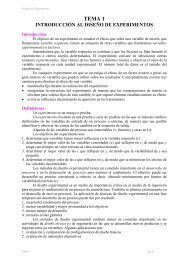Problemas - Departamento de Estadística e Investigación Operativa ...
Problemas - Departamento de Estadística e Investigación Operativa ...
Problemas - Departamento de Estadística e Investigación Operativa ...
You also want an ePaper? Increase the reach of your titles
YUMPU automatically turns print PDFs into web optimized ePapers that Google loves.
<strong>Problemas</strong> <strong>de</strong> Diseño <strong>de</strong> Experimentos (Curso 2003-2004) 5<br />
14) Se utiliza una aleación <strong>de</strong> niquel y titanio en la fabricación <strong>de</strong> componentes para turbinas <strong>de</strong> aviones. La formación<br />
<strong>de</strong> grietas es un problema potencialmente grave en la parte final, ya que pue<strong>de</strong> dar por resultado un fallo<br />
irreversible. Se realiza una prueba <strong>de</strong> las componentes en las instalaciones <strong>de</strong>l fabricante a fin <strong>de</strong> <strong>de</strong>terminar el<br />
efecto <strong>de</strong> cuatro factores sobre las grietas. Los cuatro factores son temperatura <strong>de</strong> VERTIDO, contenido <strong>de</strong><br />
TITANIO, MÉTODO <strong>de</strong> tratamiento térmico cantidad empleada <strong>de</strong> refinador <strong>de</strong> TEXTURA. Se obtienen dos<br />
observaciones para cada tratamiento, midiendo la longitud <strong>de</strong> las GRIETAS inducidas en una probeta sometida a<br />
una prueba estandar.<br />
a) ¿Qué diseño se ha utilizado?<br />
b) Los resultados obtenidos en el experimento anterior aparecen recogidos en la tabla siguiente.<br />
******Analysis of Variance – <strong>de</strong>sign 1 ******<br />
Tests of Significance for GRIETAS using UNIQUE sums of squares<br />
Source of Variation SS DF MS F Sig of F<br />
WITHIN+RESIDUAL ,08 15 ,01<br />
REPETICI ,03 1 ,03 6,08 ,026<br />
METODO ,68 1 ,68 135,18 ,000<br />
TEXTURA ,40 1 ,40 79,89 ,000<br />
TITANIO ,12 1 ,12 23,09 ,000<br />
VERTIDO ,36 1 ,36 72,08 ,000<br />
METODO * TEXTURA ,01 1 ,01 1,88 ,191<br />
METODO * TITANIO ,05 1 ,05 10,32 ,006<br />
METODO * VERTIDO ,00 1 ,00 ,14 ,714<br />
TEXTURA * TITANIO ,09 1 ,09 18,55 ,001<br />
TEXTURA * VERTIDO ,10 1 ,10 20,31 ,000<br />
TITANIO * VERTIDO ,07 1 ,07 13,39 ,002<br />
METODO * TEXTURA * TITANIO ,00 1 ,00 ,22 ,643<br />
METODO * TEXTURA * VERTIDO ,00 1 ,00 ,03 ,864<br />
METODO * TITANIO * VERTIDO ,00 1 ,00 ,33 ,575<br />
TEXTURA * TITANIO * VERTIDO ,00 1 ,00 ,27 ,609<br />
METODO * TEXTURA * TITANIO * VERTIDO ,17 1 ,17 33,65 ,000<br />
(Mo<strong>de</strong>l) 2,09 16 ,13 25,96 ,000<br />
(Total) 2,17 31 ,07<br />
R-Squared = ,965<br />
Adjusted R-Squared = ,928<br />
- - - - - - - - - - - - - - - - - - - - - - - - - - - - - - - - - - - -<br />
Analizar los resultados proporcionados por la tabla <strong>de</strong> ANOVA.<br />
15) En un proceso productivo se efectúa el siguiente diseño experimental con 8 factores para medir la plasticidad <strong>de</strong><br />
una mezcla.<br />
Datos 48 41 60 52 49 41 60 56 46 41 56 58 49 42 59 52<br />
A - + - + - + - + - + - + - + - +<br />
B - - + + - - + + - - + + - - + +<br />
C - - - - + + + + - - - - + + + +<br />
D - - - - - - - - + + + + + + + +<br />
E - + + - + - - + - + + - + - - +<br />
F - + + - - + + - + - - + + - - +<br />
G - + - + + - + - + - + - - + - +<br />
H - - + + + + - - + + - - - - + +<br />
a) ¿Qué tipo <strong>de</strong> diseño se ha utilizado?<br />
b) ¿Con qué interacciones se han confundido los efectos principales <strong>de</strong> los factores E, F, G, H?<br />
c) ¿Cuál es la ecuación generatriz asociada? Indicar la resolución <strong>de</strong>l diseño empleado.<br />
16) En el mol<strong>de</strong>o <strong>de</strong> una pieza <strong>de</strong> caucho intervienen cuatro factores: presión (A), temperatura <strong>de</strong> mol<strong>de</strong>o (B),<br />
temperatura <strong>de</strong> enfriamiento (C) y tiempo <strong>de</strong> vulcanización (D). Solamente se pue<strong>de</strong>n realizar 8 experiencias <strong>de</strong><br />
una vez, siendo posible que <strong>de</strong> una a otra ejecución, cambien las condiciones generales.<br />
a) ¿Qué tipo <strong>de</strong> diseño se podrá hacer en ese caso?<br />
b) Supongamos que se han obtenido exactamente las 8 observaciones que aparecen en la tabla adjunta.






